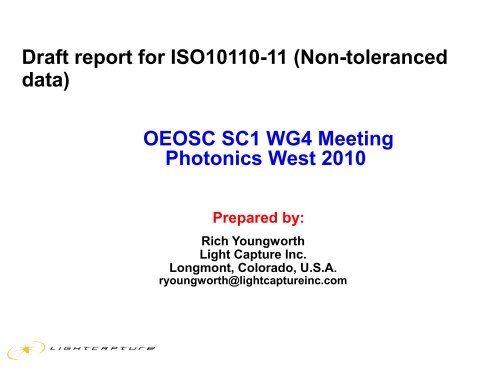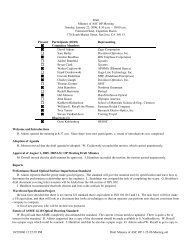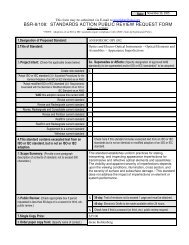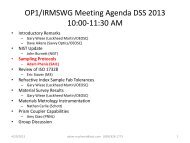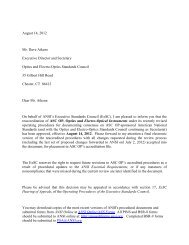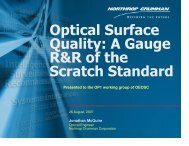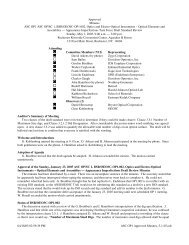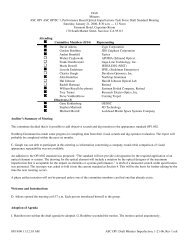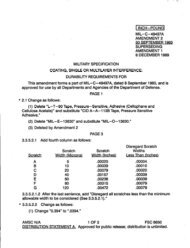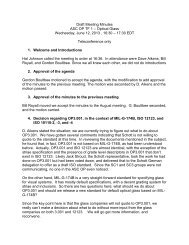Draft report for ISO10110-11 (Non-toleranced data) - Optics and ...
Draft report for ISO10110-11 (Non-toleranced data) - Optics and ...
Draft report for ISO10110-11 (Non-toleranced data) - Optics and ...
You also want an ePaper? Increase the reach of your titles
YUMPU automatically turns print PDFs into web optimized ePapers that Google loves.
<strong>Draft</strong> <strong>report</strong> <strong>for</strong> <strong>ISO10<strong>11</strong>0</strong>-<strong>11</strong> (<strong>Non</strong>-<strong>toleranced</strong><br />
<strong>data</strong>)<br />
OEOSC SC1 WG4 Meeting<br />
Photonics West 2010<br />
Prepared by:<br />
Rich Youngworth<br />
Light Capture Inc.<br />
Longmont, Colorado, U.S.A.<br />
ryoungworth@lightcaptureinc.com
Properly written st<strong>and</strong>ards include provisions when<br />
<strong>data</strong> is not specified<br />
<strong>ISO10<strong>11</strong>0</strong>-<strong>11</strong> <strong>Non</strong>-<strong>toleranced</strong> <strong>data</strong> (defaults)<br />
Last <strong>for</strong>mal ISO activity circa 2006<br />
New draft in <strong>for</strong> 20<strong>11</strong><br />
This presentation documents the <strong>data</strong>, decisions, <strong>and</strong> content<br />
of the proposed draft from the US/OEOSC perspective<br />
St<strong>and</strong>ards non-<strong>toleranced</strong> <strong>data</strong>, APOMA perspective<br />
APOMA Workshop; Tucson, AZ; Nov. 2010<br />
2
Realities of writing a “universal” set of default<br />
tolerances<br />
Defining “universal” defaults is intractable in one table. Why<br />
Effects of different materials are significant<br />
Size <strong>and</strong> thickness impact – what would be a reasonable default<br />
Varying traditional shop practice (fab <strong>and</strong> metrology)<br />
Diverse processes lead to different meaningful numbers<br />
...<br />
Multiple tables to cover the manufacturing spectrum<br />
defeat the purpose of this st<strong>and</strong>ard <strong>and</strong> likely would<br />
lead to confusion<br />
Defaults must assume “traditional” germane glass<br />
lens fabrication methods in a single table<br />
St<strong>and</strong>ards non-<strong>toleranced</strong> <strong>data</strong>, APOMA perspective<br />
APOMA Workshop; Tucson, AZ; Nov. 2010<br />
3
Makes sense <strong>for</strong> U.S. position to recommend<br />
<strong>ISO10<strong>11</strong>0</strong>-<strong>11</strong> match st<strong>and</strong>ard practice<br />
“Loose” defaults preferred from both the design <strong>and</strong><br />
fabrication perspective<br />
“These tolerances do not represent absolute limits. Even looser tolerances may be used:<br />
however they shall then be indicated in the drawing.”<br />
Challenge: determine st<strong>and</strong>ard U.S. practice, especially<br />
given different sizes, materials, fabrication processes,<br />
<strong>and</strong> metrology<br />
Ef<strong>for</strong>t to garner input has been fivefold, results utilized:<br />
ASC/OP1 WG4<br />
Public domain – old <strong>ISO10<strong>11</strong>0</strong>-<strong>11</strong>, shop public in<strong>for</strong>mation,<br />
papers <strong>and</strong> short courses, glass manufacturer <strong>data</strong><br />
Poll <strong>for</strong> input from U.S. fabrication OEOSC members<br />
Compare with catalog parts<br />
APOMA 2010 workshop <strong>and</strong> follow-up (verbal + 2 surveys submitted)<br />
St<strong>and</strong>ards non-<strong>toleranced</strong> <strong>data</strong>, APOMA perspective<br />
APOMA Workshop; Tucson, AZ; Nov. 2010<br />
4
Size classifications in the st<strong>and</strong>ard<br />
Current size classifications<br />
Up to 10mm<br />
10-30mm<br />
30-100mm<br />
100-300mm<br />
Notes on sizes without defaults:<br />
<strong>Optics</strong> smaller than 3mm are custom (<strong>and</strong> often molded)<br />
Larger than 300mm are custom<br />
Change: taking lowest category from Up to 10mm to 3-10mm<br />
(based on APOMA input)<br />
St<strong>and</strong>ards non-<strong>toleranced</strong> <strong>data</strong>, APOMA perspective<br />
APOMA Workshop; Tucson, AZ; Nov. 2010<br />
5
Defining default categories is key<br />
Keep in st<strong>and</strong>ard:<br />
Lens diameter or edge length<br />
Thickness<br />
Angle deviation of prisms <strong>and</strong> plates<br />
Chamfer/Bevel widths (value not tolerance), curved surfaces only<br />
Stress birefringence<br />
Bubbles <strong>and</strong> inclusions<br />
Inhomogeneity <strong>and</strong> striae<br />
Surface <strong>for</strong>m tolerances<br />
Centring<br />
Surface imperfection<br />
St<strong>and</strong>ards non-<strong>toleranced</strong> <strong>data</strong>, APOMA perspective<br />
APOMA Workshop; Tucson, AZ; Nov. 2010<br />
6
Defining default categories is key<br />
Categories to add:<br />
Mean index of refraction<br />
V-number<br />
Clear aperture to part edge distance<br />
Chips st<strong>and</strong>ard <strong>for</strong> prisms <strong>and</strong> plates (flat)<br />
Will not include in 20<strong>11</strong>, but keep in mind <strong>for</strong> 2016:<br />
Index change with temperature (dn/dT)<br />
Slope <strong>and</strong> sampling criteria <strong>for</strong> aspheres (-12)<br />
Texture <strong>and</strong> waviness (-8)<br />
Laser irradiation damage threshold (-17)<br />
St<strong>and</strong>ards non-<strong>toleranced</strong> <strong>data</strong>, APOMA perspective<br />
APOMA Workshop; Tucson, AZ; Nov. 2010<br />
7
Input to keep in mind when reviewing the numbers<br />
The loosest possible value from the references generally<br />
chosen (with experience also applied)<br />
Loosest grade <strong>for</strong> glasses suggested as our position<br />
- Most optical grade glass fabricated outside the US<br />
- Specialty materials (IR, low expansion, etc.) not “in play”<br />
Possible differences to note <strong>for</strong> ANSI version<br />
- Important differences will be noted (such as wavelength)<br />
- Centration to include total runout in next <strong>ISO10<strong>11</strong>0</strong>-6<br />
- US imperfection position likely will be scratch-dig (80-50)<br />
- Recategorize as needed to match ANSI versions<br />
St<strong>and</strong>ards non-<strong>toleranced</strong> <strong>data</strong>, APOMA perspective<br />
APOMA Workshop; Tucson, AZ; Nov. 2010<br />
8
Edge length proposed position suggests changes<br />
from current st<strong>and</strong>ard (units mm)<br />
3-10mm<br />
Current: +/-0.2<br />
Proposed: +0.00/-0.15<br />
10-30mm<br />
Current: +/-0.5<br />
Proposed: +0.00/-0.25<br />
30-100mm<br />
Current: +/-1<br />
Proposed: +0.00/-0.75<br />
100-300mm<br />
Current: +/-1.5<br />
Proposed: +0.00/-1.5<br />
Note: Looser than reference numbers used<br />
St<strong>and</strong>ards non-<strong>toleranced</strong> <strong>data</strong>, APOMA perspective<br />
APOMA Workshop; Tucson, AZ; Nov. 2010<br />
9
Clear aperture to part edge proposed position<br />
suggestion new <strong>for</strong> the st<strong>and</strong>ard (units mm)<br />
3-10mm<br />
Current: Not in st<strong>and</strong>ard<br />
Proposed: 0.5<br />
10-30mm<br />
Current: Not in st<strong>and</strong>ard<br />
Proposed: 1.0<br />
30-100mm<br />
Current: Not in st<strong>and</strong>ard<br />
Proposed: 1.0<br />
100-300mm<br />
Current: Not in st<strong>and</strong>ard<br />
Proposed: 2.0<br />
St<strong>and</strong>ards non-<strong>toleranced</strong> <strong>data</strong>, APOMA perspective<br />
APOMA Workshop; Tucson, AZ; Nov. 2010<br />
10
Thickness proposed position suggests one minor<br />
change from current st<strong>and</strong>ard (units mm)<br />
3-10mm<br />
Current: +/-0.1<br />
Proposed: +/-0.1<br />
10-30mm<br />
Current: +/-0.2<br />
Proposed: +/-0.2<br />
30-100mm<br />
Current: +/-0.4<br />
Proposed: +/-0.4<br />
100-300mm<br />
Current: +/-0.8<br />
Proposed: +/-0.8<br />
St<strong>and</strong>ards non-<strong>toleranced</strong> <strong>data</strong>, APOMA perspective<br />
APOMA Workshop; Tucson, AZ; Nov. 2010<br />
<strong>11</strong>
Width of protective chamfer position suggests minor<br />
changes from current st<strong>and</strong>ard (units mm)<br />
3-10mm<br />
Current: 0.1 to 0.3<br />
Proposed: No Bevel<br />
10-30mm<br />
Current: 0.2 to 0.5<br />
Proposed: 0.3 to 0.5<br />
30-100mm<br />
Current: 0.3 to 0.8<br />
Proposed: 0.3 to 0.8<br />
Notes<br />
Small parts can chip if beveled, cut<br />
out largely by 3-10mm category lower<br />
bound<br />
100-300mm<br />
Current: 0.5 to 1.6<br />
Proposed: 0.8 to 1.6<br />
St<strong>and</strong>ards non-<strong>toleranced</strong> <strong>data</strong>, APOMA perspective<br />
APOMA Workshop; Tucson, AZ; Nov. 2010<br />
12
Chips outside clear aperture is new suggestion <strong>for</strong><br />
the st<strong>and</strong>ard<br />
3-10mm<br />
Current: Not in st<strong>and</strong>ard<br />
Proposed: Larger than 0.5mm diameter stoned,<br />
Mean index of refraction <strong>and</strong> V-number are new to<br />
the st<strong>and</strong>ard<br />
Mean Index<br />
3-10mm<br />
Current: Not in st<strong>and</strong>ard<br />
Proposed: +/-0.001<br />
10-30mm<br />
Current: Not in st<strong>and</strong>ard<br />
Proposed: +/-0.001<br />
30-100mm<br />
Current: Not in st<strong>and</strong>ard<br />
Proposed: +/-0.0015<br />
100-300mm<br />
Current: Not in st<strong>and</strong>ard<br />
Proposed: +/-0.002<br />
V-number (d F C,<br />
Abbé only)<br />
3-10mm<br />
Current: Not in st<strong>and</strong>ard<br />
Proposed: +/-0.8%<br />
10-30mm<br />
Current: Not in st<strong>and</strong>ard<br />
Proposed: +/-0.8%<br />
30-100mm<br />
Current: Not in st<strong>and</strong>ard<br />
Proposed: +/-1.0%<br />
100-300mm<br />
Current: Not in st<strong>and</strong>ard<br />
Proposed: +/-1.2%<br />
St<strong>and</strong>ards non-<strong>toleranced</strong> <strong>data</strong>, APOMA perspective<br />
APOMA Workshop; Tucson, AZ; Nov. 2010<br />
14
Stress birefringence position suggests no changes<br />
from current st<strong>and</strong>ard (units nm/cm)<br />
3-10mm<br />
Current: 20<br />
Proposed: 20<br />
10-30mm<br />
Current: 20<br />
Proposed: 20<br />
30-100mm<br />
Current: Not specified<br />
Proposed: 30<br />
100-300mm<br />
Current: Not specified<br />
Proposed: 40<br />
Notes: Loosest grade of single boule material used (O'Hara)<br />
St<strong>and</strong>ards non-<strong>toleranced</strong> <strong>data</strong>, APOMA perspective<br />
APOMA Workshop; Tucson, AZ; Nov. 2010<br />
15
Bubbles <strong>and</strong> inclusions proposed position suggests<br />
changes from current st<strong>and</strong>ard (see below on units)<br />
3-10mm<br />
Current: 3 x 0.16<br />
Proposed: 3 x 0.16<br />
10-30mm<br />
Current: 5 x 0.25<br />
Proposed: 5 x 0.25<br />
30-100mm<br />
Current: 5 x 0.4<br />
Proposed: 5 x 0.4<br />
100-300mm<br />
Current: 5 x 0.63<br />
Proposed: 5 x 0.63<br />
Scale numbers<br />
<strong>for</strong> area<br />
Notes<br />
Reminder: notation is N x A (# max-size defects x<br />
square-root of area of max-size defect in mm)<br />
Glass manufacturers use cross-sectional area of<br />
bubbles in mm 2 versus 100 cm 3 volume<br />
Loosest grades: Schott 0.1, O'Hara >0.5, CDGM<br />
2 to 4 (in mm 2 versus 100 cm 3 )<br />
Could look to assess values <strong>for</strong> 0.5 mm 2 versus<br />
100 cm 3 , scaled <strong>for</strong> part size, but not crucial as<br />
current numbers seem reasonable (not worth any<br />
battle)<br />
St<strong>and</strong>ards non-<strong>toleranced</strong> <strong>data</strong>, APOMA perspective<br />
APOMA Workshop; Tucson, AZ; Nov. 2010<br />
16
Inhomogeneity <strong>and</strong> straie proposed position suggests<br />
no changes from current st<strong>and</strong>ard (see below on units)<br />
3-10mm<br />
Current: 1;1<br />
Proposed: 1;1<br />
10-30mm<br />
Current: 1;1<br />
Proposed: 1;1<br />
30-100mm<br />
Current: Not specified<br />
Proposed: 1;1<br />
100-300mm<br />
Current: Not specified<br />
Proposed: 1;1<br />
Notes<br />
Only grades allowed<br />
Homogeneity designation means 20 partsper-million<br />
(max refractive index variance)<br />
Striae is challenging to compare to glass<br />
grades (they use MIL-G-174B)<br />
<strong>ISO10<strong>11</strong>0</strong> striae is % area with 30nm of<br />
OPD (thickness ambiguity), grade 1 is
Surface <strong>for</strong>m tolerances proposed position suggests<br />
changes from current st<strong>and</strong>ard<br />
3-10mm<br />
Current: 5(1)<br />
Proposed: 5(1)<br />
10-30mm<br />
Current: 10(2)<br />
Proposed: 5(2)<br />
30-100mm<br />
Current: 5(1), 30mm diam. samples<br />
Proposed: 5(2), 30mm diam. samples<br />
100-300mm<br />
Current: 10(2), 30mm diam. samples<br />
Proposed: 8(2), 30mm diam. samples<br />
Notes<br />
Notation is A(B) in fringes at<br />
Hg line 546.07nm<br />
A is sagitta specification<br />
(radius tolerance)<br />
B is irregularity<br />
Should we put in nm <strong>for</strong><br />
interferometry<br />
i.e. would 3-10mm value be<br />
written as:<br />
3/1365nm(546nm)<br />
St<strong>and</strong>ards non-<strong>toleranced</strong> <strong>data</strong>, APOMA perspective<br />
APOMA Workshop; Tucson, AZ; Nov. 2010<br />
18
Notes <strong>and</strong> details <strong>for</strong> angle deviation <strong>for</strong> prisms <strong>and</strong><br />
plates <strong>and</strong> centring<br />
Lens wedge is tough to find consensus – assuming a 1” optic we have:<br />
Source 1: 5-6'<br />
Source 2: ~17' (125um TIR)<br />
Source 3: 2' in ISO terms but TIR 0.05mm is 7'<br />
Source 4: TIR 0.05mm is 7'<br />
Survey 1: 100um TIR is 13.5'<br />
Survey 2: matched current st<strong>and</strong>ard <strong>for</strong> first two columns (30', 20')<br />
Old default of 10'-30' is still seems quite loose<br />
Initially thought 8' made sense, with surveys, it makes sense to tighten, but not<br />
as much as first considered (in keeping with the spirit of having the numbers<br />
loose)<br />
Can convert to TIR <strong>for</strong> ANSI, using lower end of the size <strong>for</strong> default numbers<br />
Beam deviation was posed as a good metric verbally by one person (but in<br />
minority compared to TIR)<br />
St<strong>and</strong>ards non-<strong>toleranced</strong> <strong>data</strong>, APOMA perspective<br />
APOMA Workshop; Tucson, AZ; Nov. 2010<br />
19
Resulting values <strong>for</strong> cetnring <strong>and</strong> angle deviation <strong>for</strong><br />
prisms <strong>and</strong> plates (units arcmin, can do ANSI TIR)<br />
Centring<br />
Angle deviation of prisms <strong>and</strong> plate<br />
3-10mm<br />
Current: +/-30<br />
Proposed: +/-20<br />
10-30mm<br />
Current: +/-20<br />
Proposed: +/-15<br />
30-100mm<br />
Current: +/-10<br />
Proposed: +/-10<br />
100-300mm<br />
Current: +/-10<br />
Proposed: +/-10<br />
3-10mm<br />
Current: +/-30<br />
Proposed: +/-30<br />
10-30mm<br />
Current: +/-30<br />
Proposed: +/-30<br />
30-100mm<br />
Current: +/-30<br />
Proposed: +/-30<br />
100-300mm<br />
Current: +/-30<br />
Proposed: +/-30<br />
St<strong>and</strong>ards non-<strong>toleranced</strong> <strong>data</strong>, APOMA perspective<br />
APOMA Workshop; Tucson, AZ; Nov. 2010<br />
20
Surface imperfection tolerances proposed position<br />
suggests changes from current st<strong>and</strong>ard<br />
3-10mm<br />
Current: 3 x 0.16<br />
Proposed: 80-50 (ANSI only)<br />
10-30mm<br />
Current: 5 x 0.25<br />
Proposed: 80-50 (ANSI only)<br />
30-100mm<br />
Current: 5 x 0.4<br />
Proposed: 80-50 (ANSI only)<br />
100-300mm<br />
Current: 5 x 0.63<br />
Proposed: 120-80 (ANSI only)<br />
Notes<br />
ISO units are Number x Size of surface<br />
imperfections (again using square root of<br />
defect area)<br />
Proposed are ANSI only, as scratch-dig<br />
similar to MIL-PRF 13830B<br />
ANSI/OEOSC OP1.002:2009 (or current<br />
version)<br />
U.S. position should be to avoid giving<br />
explicit input to this ISO st<strong>and</strong>ard <strong>for</strong><br />
defaults, unless someone feels strongly<br />
that we should do it<br />
St<strong>and</strong>ards non-<strong>toleranced</strong> <strong>data</strong>, APOMA perspective<br />
APOMA Workshop; Tucson, AZ; Nov. 2010<br />
21
The path <strong>for</strong>ward <strong>for</strong> completing our position on the<br />
st<strong>and</strong>ard <strong>and</strong> disseminating in<strong>for</strong>mation<br />
Proper <strong>for</strong>mal draft <strong>for</strong> OEOSC completed January, 20<strong>11</strong><br />
(pending PW input)<br />
OEOSC process<br />
ANSI draft version<br />
International community reception<br />
Separate activity: Aikens/Youngworth paper on this part of<br />
the st<strong>and</strong>ard invited at Optifab<br />
St<strong>and</strong>ards non-<strong>toleranced</strong> <strong>data</strong>, APOMA perspective<br />
APOMA Workshop; Tucson, AZ; Nov. 2010<br />
22


